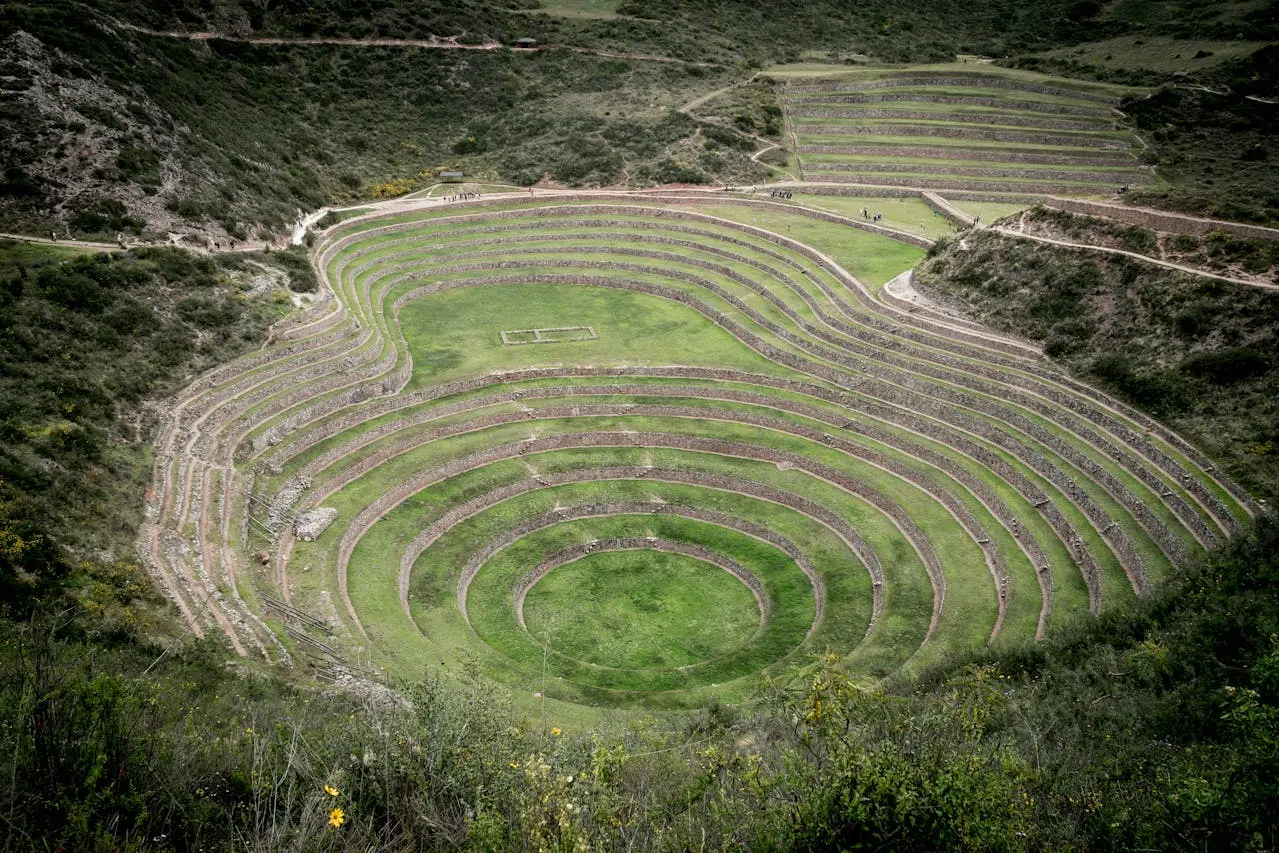Hidden in the heart of the Sacred Valley, the Moray ruins offer travelers a glimpse into the innovative spirit of the Inca Empire. More than just a site of visual wonder, Moray stands as a testament to ancient agricultural ingenuity an essential stop for those seeking authentic and enriching experiences in Peru.
When planning your journey through Cusco and the Sacred Valley, Machu Picchu usually takes center stage but just an hour and a half away lies one of the Inca civilization’s most intriguing feats: Moray.
Imagine circular terraces carved deep into the Andean earth, layered like an amphitheater of science. This is not just a visual spectacle it’s a mystery that blends agricultural experimentation, spiritual significance, and ancient engineering.
Whether you’re an experienced traveler in search of hidden gems or a curious family looking to explore Peru’s heritage, Moray is a must-visit site that deserves a spotlight in your itinerary.
What is Moray in Cusco?
Moray is one of the most fascinating and visually striking archaeological sites in the Sacred Valley of the Incas, located near the town of Maras in the Cusco region of Peru. This extraordinary site features a complex system of concentric circular terraces, ingeniously carved into natural sinkholes in the high Andean landscape.
These terraces descend in levels, with the largest reaching up to 30 meters (98 feet) deep. Each level has its own microclimate, with temperature variations of up to 15°C (27°F) between the top and bottom. Archaeologists and researchers believe that the Incas used Moray as an advanced agricultural laboratory, where they conducted experiments to adapt crops to different climatic conditions. This innovative system allowed them to simulate diverse environments and optimize farming techniques across the empire.
Moray stands as a testament to the Incas’ deep understanding of agriculture, engineering, and environmental management. Visiting Moray offers a unique opportunity to witness the scientific ingenuity of a civilization far ahead of its time, making it a must-see destination for travelers interested in history, innovation, and cultural heritage.
Fun Fact: The temperature difference between the top and bottom levels can reach up to 20°F (11°C), allowing for a variety of crops to grow at different "altitudes" in one space.
Theories and Purpose: What Was Moray Used For?
1. Inca Agricultural Laboratory
Most scholars believe that Moray served as an experimental farm for the Incas to test crops under various microclimates, enhancing food security across the empire.
2. Ceremonial Use
Local festivals like Moray Raymi suggest that Moray may have also held spiritual or ceremonial importance, possibly connected to Pachamama (Mother Earth).
3. Astronomical Alignments and Design
Its geometry and orientation may have helped the Incas track celestial movements, aligning agricultural cycles with seasonal changes.
Where is Moray Located and How Do You Get There?
Moray is located near the town of Maras, just 7 km from the famous Maras Salt Mines and about 50 km (31 miles) from Cusco.
- How to Get There: Private Tour: Best option for comfort, guide-led exploration, and itinerary flexibility.
- ATV Adventure Tour: For thrill-seekers, combine Moray with Maras and enjoy scenic routes through the highlands.
- Taxi or Rental Car: Independent option, but less informative.
- Public Transport: Limited and not direct only recommended for adventurous budget travelers.
What to See and Do at Moray
- Walk Around the Terraces: Take your time exploring each level and marvel at the sophisticated design.
- Photography: Moray is exceptionally photogenic, especially during golden hour.
- Learn from a Guide: Unlock the science and mythology with expert-led insights.
- Combine with Maras Salt Mines: Only 15 minutes away and offers great contrast to Moray’s green terraces.
Best Time to Visit Moray
| Season | Months | Conditions |
|---|---|---|
| Dry Season | May to October | Clear skies, best for photography |
| Shoulder Season | April & November | Fewer crowds, pleasant weather |
| Rainy Season | December to March | Green landscapes but slippery conditions |
Is Moray Suitable for All Types of Travelers?
Absolutely! Moray offers something for everyone:
- Families: Educational and visually engaging for kids and teens.
- Adventure Seekers: Combine with biking or hiking routes.
- Photographers: Capture dramatic Andean backdrops.
- History Buffs: Dive deep into ancient innovation.
What to Bring When Visiting Moray
- Sunscreen and hat (high UV exposure)
- Water and snacks
- Comfortable walking shoes (gravel paths)
- Light jacket (weather can change quickly)
- Camera or smartphone with wide lens
Moray isn’t just an archaeological site it’s a story written in stone, a laboratory without walls, and a mirror into the Inca mindset. It’s where nature and knowledge fused, creating a site that still baffles and inspires visitors today.
If you're looking for something beyond the typical tourist trail something that combines science, mystery, and breathtaking scenery then Moray is the perfect chapter in your Sacred Valley journey. Contact us now to star planing your moray tour.

